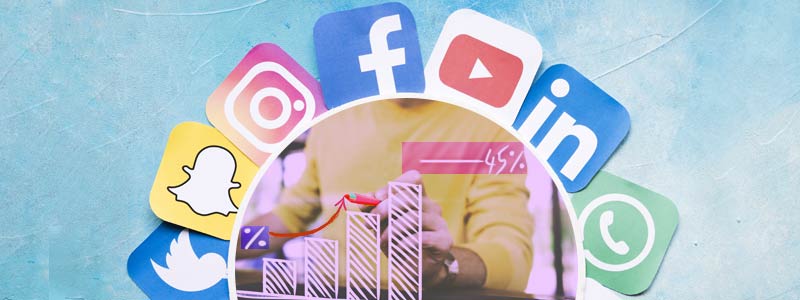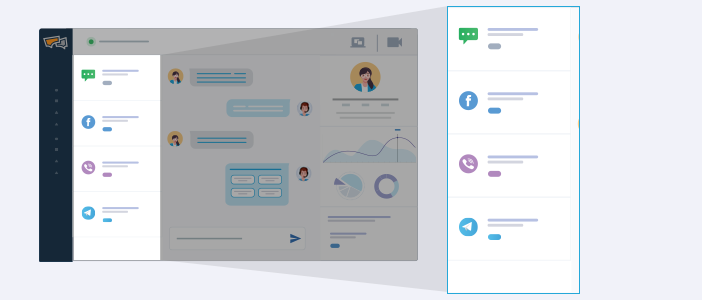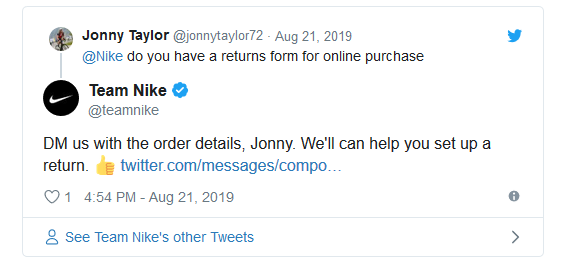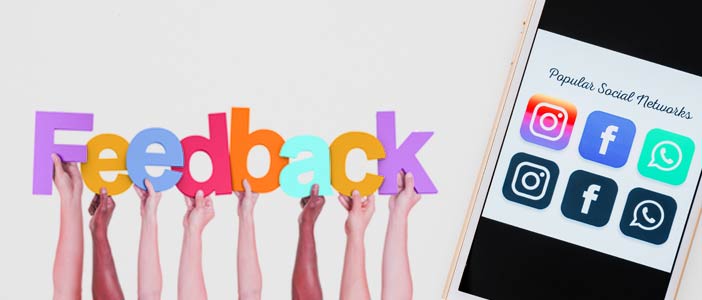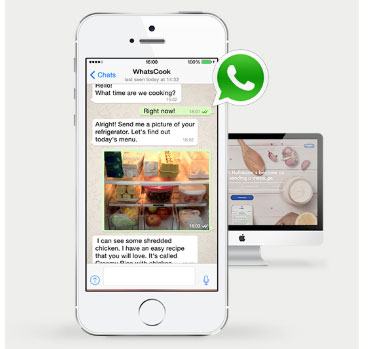The impact of social media on business, both positive and negative, is immense.
Do you agree? 90% of businesses agree with this.
Whether you are a startup or a small business, whether you are an online store or an enterprise, social media is vital for your business marketing strategy.
According to a recent survey, 71% of consumers who have had a good social media service experience with a brand are likely to recommend it to others. It shows the importance of social media for businesses. In order to maintain a competitive pace, businesses are bound to leverage popular social media platforms.
Social platforms help you connect with your customers, boost brand awareness, and increase your leads and sales. With close to five billion people across the globe using social media, it’s no passing trend.
Why Is It Important to Use Social Media for Businesses?
Social media has greatly transformed the business landscape. It is one of the most important aspects of digital marketing, which provides incredible benefits that help reach millions of customers worldwide.
If you are a CEO or a small business owner, it is very important to know why you need to be on social media and how it is going to affect your business.
There are several questions you must ask yourself before you plan your social media strategy
- What are the channels where my customers are present?
- What are the ways to target my audience on those channels?
- What are my objectives and the RoI of the social media strategy?
So, it is evident that how social media can have an immense impact on your business and can be one of the most powerful marketing channels to reach out to your audience.
In a nutshell, social media for businesses has benefited in three key areas.
Brand building – social media is one of the most profitable digital marketing platforms that boosts your brand’s visibility among potential customers, allowing you to reach a larger audience. By applying a social media customer service strategy, you significantly increase your brand’s recognition.
Omni channel engagement – Research shows that 60% of US millennials expect consistent experiences when dealing with brands online, in-store, or by phone. Social media strategies boost user engagement across channels in order to engage customers and deliver a better omnichannel customer experience.
Business growth – Social interaction between businesses & customers is a growing trend that increases sales and improves brand loyalty. According to the SMM report, more than 65% of businesses are on social media to increase leads.
So, let’s look at how does social media affect businesses.
Positive Effects of Social Media on Business
Social media impacts businesses positively and offers an opportunity for your audience to find you on social media. It helps you reach your targeted audience, stay engaged with them, and respond to their queries instantly. It is a great way to evaluate your competition by monitoring their social media pages.
The impact of social media on global business is huge, in terms of brand recognition, customer engagement, revenue, and customer service. It is also a great tool to evaluate your competitors and how they are using social media for their growth.
Here are 9 positive ways of which social media impacts businesses.
#1. Social Media Adds a New Dimension to Your Omnichannel Customer Service
Today’s customers choose social media as the main source to interact with a brand because they get instant attention. Research says that 42% of consumers expect a response on social media within 60 minutes.
Social media is a powerful channel to engage customers who reach out to you through different social media channels such as Facebook, Twitter, LinkedIn, Instagram, and Whatsapp to deliver a seamless omni-channel messaging experience.
Providing omnichannel customer service is an important aspect of a business. However, it is even more important to use the right tools, and systems that can help your business deliver an omnichannel experience across the customer lifecycle.
In order to deliver omnichannel customer service, you can use certain tools. One such tool is REVE Chat, which is a multi-channel live chat platform that streamlines customer conversations across website, social, mobile, and messaging apps to deliver great customer service and increase team productivity.
Sign up with REVE Chat today! Engage your customers across their preferred social channels and respond to their messages and comments instantly.
Nike followed an excellent customer service strategy. It has one of the strongest customer service accounts on Twitter. They feature a dedicated Twitter account, Team Nike, which provides support seven days a week and in seven languages.
When a customer mentions Nike’s main Twitter handle, @teamnike responds instantly. This shows how dedicated the brand is to solving its customers’ problems.
Best practices:
- Pay attention to all customer service issues and be kind to them in all scenarios. Passive complaints that are left unaddressed can easily cause a rift between the vendor and the customer.
- Manage your social conversations promptly in order to deliver superior customer service.
- Enhance your customer experience by being available across all the touchpoints that customers prefer to contact you to deliver instant support.
#2. Social Media Helps to Reach Out to a Bigger Audience
A report by Search Logistics, 90% of marketers say their social marketing efforts have increased exposure for their business, and 75% say they’ve increased traffic. It is an ideal way to create brand awareness and stay in contact with your customers.
Social media platforms are becoming the main source for people to learn more about businesses – the latest information about new products, services, advertisements, deals, or promotions.
Here are some tips to expose your brand to a broader audience.
- Segment your audience – Prior to heading up to the social platforms make sure that your target audience is on the platform or not. It’s not at all wise to blindly follow other brands.
- Make use of visuals – Once you have segmented your audience make use of attractive visuals along with content to grab immediate attention and boost engagement.
- Initiate conversations – Involve yourself in the social platforms not only by listening but also by building great conversations by tagging or mentioning others.
- Measure your efforts – It is very important to measure your social activity by using external tools. Gain insights and channel your efforts and strengthen your brand image.
The social channels allow the sharing of business news and even posting related photos or links to stories/studies in their industry. It also builds trust with its customers and showcases itself to a new demographic of potential clients. You can also use them to add value to your guerrilla marketing examples in a subtle way.
Best Practices:
- Identify your target audience, their patterns, and behaviors, and then choose the right social media channels for your business.
- Social media is a place to forge connections and give your brand a voice. Ensure that your tone is consistent, friendly, and suits the business that you are trying to showcase.
- Visual and engaging content is key. To publish relevant, quality content and involve your audience – ask questions, use polls, and host events.
#3. Social Media Creates Word of Mouth
Social media feeds for businesses help get the word out about your business. With the arrival of interactive and social media, the patterns, roles, and impact of word of mouth have evolved. Due to this, new online communities are forming.
Such changes affected the ways businesses can leverage the power of word of mouth for marketing purposes and, vice versa, the impact of word of mouth on businesses. As per Qualtrics, 72% of people see online reviews in the same light as personal recommendations made by friends and family.
Great word-of-mouth marketing example – Threadless
Threadless is an online community of T-shirt designers and a platform where they can submit and vote on T-shirt designs. The designers were paid 20% in royalties, and either Threadless gift cards or cash.
The members were happy to promote their designs and bring more people to the site through good word of mouth.
Best Practice:
- Offer an incentive such as a discount, a free product, or an extended service to your customers so that they take the time to promote your business.
#4. Social Media Marketing (SMM) is Economical
Many businesses are jumping on the Social Media Marketing (SMM) bandwagon as it has a positive impact on brands and promises profitable success when done properly. Social media marketing techniques target social networks and applications to spread brand awareness.
Social media marketing is perceived as a more targeted type of advertising, and therefore it is very effective in creating brand awareness. Social media engagement campaigns produce a lot of shares, generate more views, and generate publicity for your business – all for a one-time cost.
Social media marketing campaigns usually center around:
- Establishing a social media presence on major platforms
- Creating shareable content and advertorials
- Cultivating customer feedback throughout the campaign through surveys and contests
A single person sharing or re-tweeting a message from your company could reach hundreds or even thousands of people for virtually no cost! Businesses that miss out on this with social media strategies that don’t generate engagement are losing a major opportunity.
Best practice:
- If you are a startup or small business, use social media marketing to promote your business and save money.
#5. Social Media Allows Collecting First-Hand Customer Feedback
Social media is a potent ingredient of customer feedback cocktail.
Social media platforms allow for collecting first-hand feedback from customers to improve the brand’s image, reputation, and relationship with them. The customer must feel like they are heard, valued, and this makes them happy.
So, respond to every post, comment, and suggestion and make the best use of them for your brand’s development. Businesses that engage with customer service requests via social media earn 20% – 40% more revenue per customer.
This will allow you to showcase just how much you care about providing a memorable experience and will ensure that no customer feedback goes unnoticed. And by monitoring social media for customer feedback and offering a response, you can drive real business results.
Best practices:
- Respond even if the user has not directly tweeted at you or asked for help. When you answer brand mentions or comments it shows you are paying attention.
- Promote your customers by retweeting a happily resolved support interaction. It is like giving your customers a big thank you.
- Give your customer service team a public face. Use a team photo or an agent spotlight. It’s nice to connect the face of the brand with the names behind it.
- Try to follow-up a resolved interaction with, “How is everything?”
#6. Social Media Improves User Engagement
No matter whether businesses are on social media or not, customers follow their social media accounts every day. With the average person spending just under two hours per day on social media, social media engagement is essential to make sure your brand is capturing enough attention.
Setting up a social media presence, building and engaging them effectively with quality content is a big effort. But the biggest benefit you can glean from your investment in social media is to reach out to your potential customers wherever they can be found across the globe.
Social media engagement is positive because of the reputation it generates for your brand but on the other hand, a single negative tweet can bring bad publicity overnight, which is difficult to reverse. Below are a few best practices for engaging users.
Best practices:
- Keep your brand at the top of the newsfeed by posting witty and engaging content regularly.
- Images increase the interaction rates so use images.
- Try being personal with your audience. Make them feel there are real people behind the brand.
#7. Social Customer Service is the New Marketing
Providing stellar customer service is likely already a top priority for every business. But along with the two-way communication that social media provides, it also offers a unique opportunity to step up your customer service game and provide instant gratification to your target audience.
WhatsApp, for example, is the most popular channel for customer service on a global scale. The numbers say there are more than 1.5 billion monthly active users, sharing more than 60 billion messages every day, a huge amount of on-platform activity.
WhatsApp Business app, launched by WhatsApp, enables business users to “interact with customers easily by using tools to automate, sort, and quickly respond to the messages”.
Hellmen is one of the best examples to show the impact of social media on business. Hellman wanted more Brazilians to cook with their mayonnaise and they thought of an interesting campaign using WhatsApp.
The campaign had the option to connect with a chef through WhatsApp. Once connected with the chef, they only had to click a picture of their fridge and share. Now the chef would plan a recipe out of it and cook the meal together, staying connected through WhatsApp.
Social media best practices:
- You should be prompt in responding to online reviews. Customers share their positive as well as negative feedback over social media. Respond to your social media comments quickly. You need to respond to them as priority else it will affect your brand image.
#8. Social Media Can Be a Driving Force of Growth Tools
The impact of social media in marketing offers opportunities for brands to increase conversions due to the interaction that they have with customers. When a brand chooses a proactive social media marketing approach, it will strengthen its marketing strategy.
Hubspot research social media marketing has a 100% higher lead-to-close rate than outbound marketing. This data proves social media marketing critical for all brands, big or small, and especially those who are trying to increase sales revenue.
Twitter is a good example of this. According to MediaBistro, 67% of Twitter users are more likely to buy from brands that they follow. Besides, 42% of consumers learn about the products and services they are interested in through Twitter. This type of outreach cannot be ignored.
Best practices:
- Use targeted social media listening to understand what is happening in your industry.
- Get engaged in social selling (social selling combines the elements of social listening, social media lead generation, and sales practices).
#9. Social Media Boosts Your Brand Loyalty
“A brand is nothing but an expression of the customer’s loyalty and trust.”
Building and maintaining brand loyalty is one of the central themes of every business. Social media helps you build relationships with your customers, which increases loyalty and advocacy.
Brand loyalty matters due to the following reasons:
- Resistance in competition – In this competitive market, brand loyalty is hard to come by. Customers have multiple options accessible that can lose them easily. Perception of your brand builds new customers but loyal customers add real value.
- Meaningful engagement – Loyal social media followers are more likely to interact with your posts and create meaningful conversations. Real engagement is more valuable to your online image.
- Brand advocacy –Loyal social media followers are high potential brand advocates. They’re very likely to talk positively about your brand, even without persuasion.
Developing brand loyalty ensures long term engagement on social media. Research shows, 66% of users between the ages of 18 and 24 are more loyal to the brands they follow on social media.
Best practices:
- You should create a smart social media strategy that comprises a cohesive plan to keep up with your competition.
- Share good quality content to inspire brand loyalty. Visual content gets easily noticed. So, use infographics, videos, screenshots, graphs, etc. to make content more appealing.
- Ensure that you are not sidelining interactions as followers, like humanized interactions, not bots or automated content.
Impactful Components of Social Media Marketing
In the realm of social media marketing, a powerhouse of impactful components works its magic to connect with your target audience, build up that brand buzz, and spark some serious engagement! Imagine it like a thrilling recipe for online success – here are the key ingredients that make it all happen:
-
Content
Picture social media marketing like a big storytelling adventure, and at the heart of it all is content – the real hero! Businesses create and share engaging, useful, and spot-on info for their users, helping them stay super awesome. Whether it’s words, pics, videos, or catchy graphics, it all adds up to a mega message. But here’s the magic: when people love what they see, they share it with their friends, making the brand’s story reach even to more people!
-
Audience Targeting
Social media platforms allow for precise audience targeting based on demographics, interests, and behavior. Understanding and defining the target audience ensures that marketing efforts reach the right people.
-
Social Listening
Monitoring and responding to conversations on social media provide valuable insights into audience preferences, concerns, and trends. Social listening allows marketers to adapt strategies based on real-time feedback.
-
Influencer Marketing
Imagine influencer marketing as your favorite online playground where great things happen! In this always-changing digital world, influencer marketing platforms are the must-have tool for businesses who want to reach more people and have some real fun. These platforms are like magical bridges, connecting brands with influencers in the big, wide world of social media.
-
Hashtag Campaigns
Creating and promoting branded hashtags can enhance discoverability and encourage user participation. Hashtag campaigns help in organizing content and building a sense of community around a specific topic.
Impact of Social Media on Different Industries
In a world where social media is the talk of the town, its impact on different industries is nothing short of extraordinary. From changing how we shop to influencing our travel plans and even shaping what we watch, social media is the game-changer. Let’s take a closer look at how our favorite platforms are not just connecting friends but also reshaping the way businesses work in retail, healthcare, travel, and more.
Travel & Hospitality Industry
Social media has made a big splash in the travel and hospitality world! Think Facebook, Instagram, and TripAdvisor – they’re like the superheroes for hotels and resorts. These platforms aren’t just for sharing selfies; they’re crucial for making places famous, chatting with travellers, and posting cool stuff. Hotels use social media to show off their awesome pools, talk to guests, and make sure everyone knows their vibe. It’s not just about posting pretty pictures; it’s a way for hotels to talk directly to guests, answer questions super fast, and make sure everyone has an amazing stay. And guess what? Social media isn’t just fun; it can actually influence where people decide to go and how they feel about their trips!
Healthcare
Social media is a big deal in healthcare! It works as a super useful tool for sharing info, talking with patients, and making communities stronger. Health groups use it to teach people about staying healthy, talk about important health stuff, and connect with patients. And you know what’s the best part? It helps break down the stigma around health issues and gives people a supportive place to chat online.
eCommerce
Social media has totally changed the game for shopping online! It’s a big deal for stores and online shops, making everything super different and exciting. Now, places like Instagram, Facebook are great places for promoting and selling things. They help businesses show off their great stuff, put out ads that are just for certain people, and make lots of sales online.
Food and Beverage
Social media has transformed the food and beverage industry by providing a platform for visual storytelling, food trends, and influencer marketing. Platforms like YouTube, Instagram, and TikTok have become hubs for sharing aesthetically pleasing food content, influencing culinary preferences and restaurant choices. Brands leverage user-generated content and collaborate with food influencers to create engaging campaigns, driving brand awareness and consumer loyalty.
Education Sector
Education got a major makeover, thanks to social media! Now, learning isn’t just in the classroom—it’s online too! Students and teachers can team up, share what they know, and make learning super fun. Social media also helps schools chat with students who might want to join, share interesting materials, and tell everyone about the awesome programs they have. It’s like bringing school to your screen!
Finance and Banking
Social media plays a multifaceted role in the finance and banking industry, serving as a platform for customer engagement, financial education, and market analysis. Financial institutions utilize social media for brand building, customer service, and real-time communication. Additionally, platforms like Twitter and LinkedIn are instrumental in sharing industry insights, market trends, and updates on financial products, contributing to a more informed and interconnected financial landscape.
Final Thoughts
The impact of social media on business performance is undeniable, as companies increasingly leverage these platforms to enhance their brand visibility, engage with customers, and drive strategic marketing initiatives.
Social media can have both positive and negative impact on business, as it can enhance your brand value while also carrying the risk of negative publicity and reputation damage if not managed effectively. However, to avoid the negative aspects, you can follow the suggested tips and be careful when sharing content on social media.
